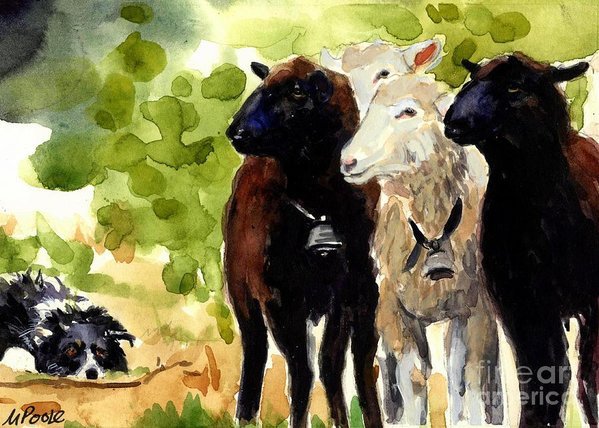
Herding breed owners who work their dogs on flocks, stock or a brace, already know all about “eye.” It refers to the amount of staring a dog will do at the animals they are charged to control. Interestingly, in his book, The Farmer’s Dog, author, John Homes, describes “eye” as “more an attitude of approach than anything connected with the dog”s eyes.” That said, there are terms used to describe exactly what a dog is – or isn’t – doing with his eyes.
A “loose-eyed” dog doesn’t try to make constant eye contact with the stock. There is less intensity, and such a dog tends to survey the entire flock. Interestingly, dogs that are loose-eyed also tend to have a different body posture than a strong-eyed dog. They are more relaxed, and have a more upright body position. They might even turn away from the stock.
“Medium eyed” or “roving eyed” dogs are sometimes “lumped” under the umbrella term of “loose eyed,” but there are subtle differences. A medium eyed dog will make eye contact with, say, a ewe, but he won’t look at her constantly. Every so often, he may switch between looking at her and not looking at her, and this serves to let the ewe relax. If the situation calls for it, the dog may stare when precision work is required, but by and large, the dog’s eye is “used only as needed.”
A dog with a roving eye not only looks over the entire flock, he looks for any sign, from an ear twitch to the quiver of the flank, that one critter is thinking of making a run for it. This dog will zero in on the individual as if to say, “Don’t ever think about it.”
As bad is it might sound to a novice, a dog with “no eye,” or “anti-eye” can be very useful, and should actually be admired. This dog will, as the term sounds, deliberately look away – or pretend to – from the animals in his charge to reduce the pressure on them. There are some animals, particularly those that are unaccustomed to dogs, that feel inspired to fight when stared at. It’s not that such a dog isn’t engaged, he is. He’s simply demonstrating a sophisticated instinct to “back off” because he senses that the stock will relax if he looks away. In fact, a real anti-eyed dog is always looking, but out of the corner of his eye. If need be, an anti-eye dog will set things right with a well timed glare.
“No eye” is not the same thing as “anti-eyed.” Dogs who demonstrate no eye at all, not loose, medium, roving or otherwise, are said to be non-eyed dogs.
At the other end of the style spectrum is the “strong-eyed” dog. These dogs have almost continuous eye contact with the stock, and some breeds, like the Border Collie, will actually have a fixed stare often accompanied by a crouching stance reminiscent of a predator stalking its prey: the dog lowers the complete height level of the body consistently while working, and belly close to the ground while moving. As an aside, dogs that move like this demonstrate an amazing amount of flexion in the front leg joints of their shoulder and elbow, and in the pastern and the rear leg joints of their hip, stifle, and hock. This allows the elbow and stifle joints to almost reach the level of the spine, and the topline appears level when moving. Strong-eye dogs usually work silently and are typically quite intense. When approached by a strong eyed dog, stock will move away to stay ahead of what looks like a predator to them. Needless to day, livestock tend not to relax under a strong-eye, though it works really well with light livestock (heavy livestock, not so much).
Too much eye can be problematic, and such dogs have what’s called “Sticky Eye.” They can be maddening to work with because they get stuck in one place for a while, then dart to a new position too quickly and unexpectedly for the startled sheep’s taste. Sometimes these dogs stop responding to commands to stop doing a hold and to start moving the #%$# livestock. Mostly, they just want to stare down livestock and prefer to keep them from moving than to actually move them.
An example of a “strong-eyed” dog is, not surprisingly, the Border Collie. This style works quite effectively as evidenced by the dogs hired earlier this year to control a Canada Goose problem in Littleton, Colorado. The Border Collie’s staring mimic the natural predator of geese, and they pay attention!
Image: “All Eyes” by Molly A Poole
http://www.granitedog.com
http://fineartamerica.com
https://www.facebook.com/MollyPooleArtist?fref=ts

“Eye” is an interesting interpretation, the eye brows are often the indicators when directing stock. Some dogs have very well developed eyebrow muscles emphasised by them being a different colour to the surounding area as in tri-colours. Dogs with shaggy facial hair such as Bearded Collies do not have the same impact on stock with their eye although their working style may include eye. I enjoyed this article thank you
Thank you for a lovely comment, Tull! It’s a fascinating topic, to be sure.